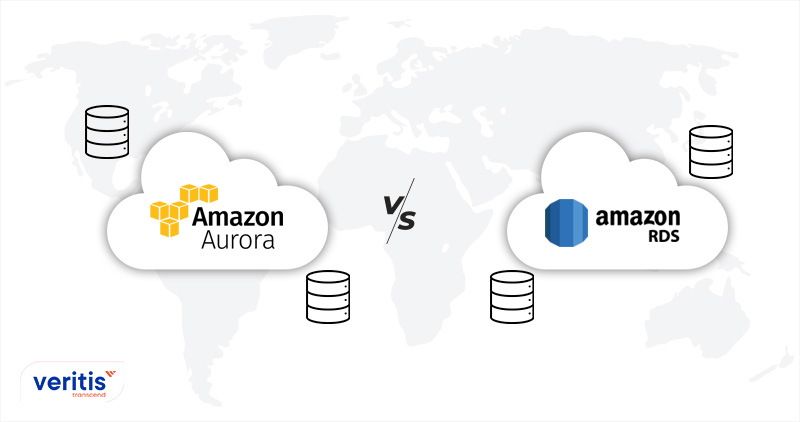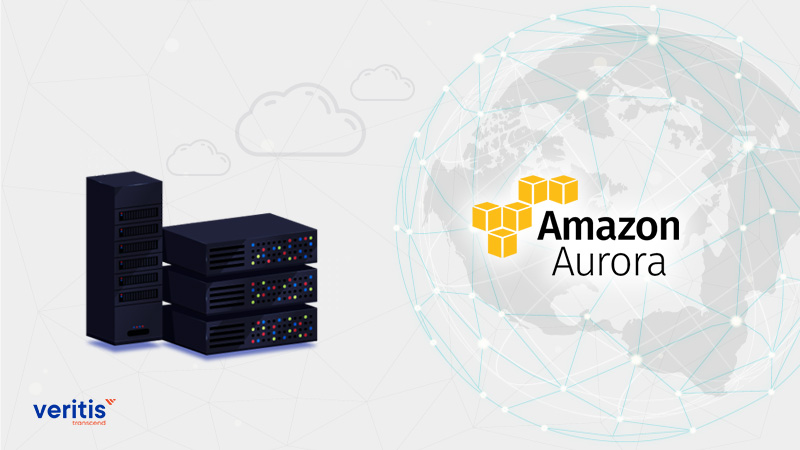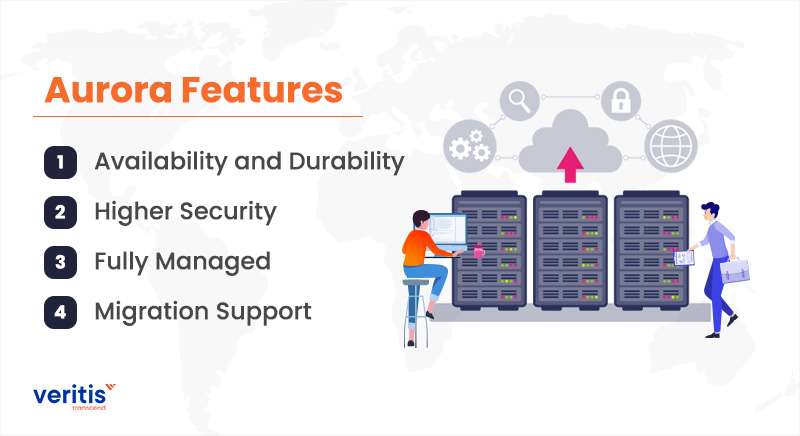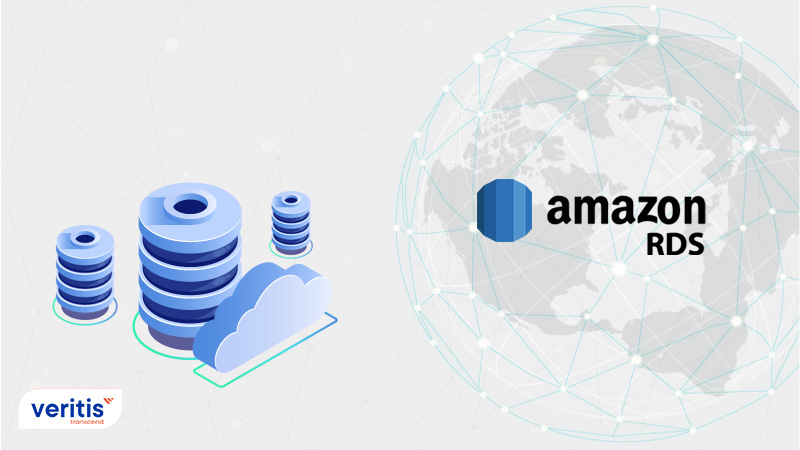
Databases are the main pillars for any application as they are one of the most essential components for business infrastructure. Additionally, database management services also became a vital part not only in on-premises but also in the cloud platform.
Database-as-a-service (DBaaS), also known as Managed Databases permits users to set up, operate, and scale databases without maintaining, and managing their underlying technologies. It allows most organizations, and individuals to opt for a cost-efficient solution. Database administrators (DBA) are facing more challenges, and problems while increasing workloads, and database complexity as most IT organizations are moving towards an application-centric approach.
Aurora is a relational database created especially for the cloud. It combines the accessibility and affordability of open-source databases with the functionality and performance of standard enterprise databases. It is completely managed and works with PostgreSQL and MySQL.
RDS is a managed database service for SQL (Structured Query Language). It is offered by Amazon, much like Aurora. RDS supports a wide range of database engines for managing and storing data. It also includes relational database maintenance tasks, including data migration, backup and recovery, and patching.
In 2023, Amazon Aurora continues to demonstrate its dominance as the fastest-growing relational database service, experiencing an astounding 200% year-over-year growth rate in 2022, as highlighted in the AWS re: Invent 2023 keynote. This exceptional growth is reflected in its market share, reaching 1.19%, making it a compelling choice for organizations seeking a robust and scalable database solution.
Widely adopted globally, Amazon Aurora boasts over 100,000 customers spanning 185 countries, cementing its position as a globally trusted platform (Source: Amazon Web Services website). Furthermore, the 2023 RightScale State of the Cloud Report affirms that Amazon Aurora is the go-to choice for production workloads, emphasizing its reliability and performance in critical business operations.
Simultaneously, Amazon RDS maintains its status as the most popular relational database service with a substantial % market share of 5%, catering to an impressive 2 million customers across more than 190 countries (Source: Amazon Web Services website). Its versatility is evident in its application across various workloads, including web, mobile, and enterprise applications, showcasing its adaptability to diverse organizational needs (Source: Amazon Web Services website).
The 2023 RightScale State of the Cloud Report reinforces the cost-effectiveness of Amazon RDS, positioning it as a pragmatic solution for running relational om’.databases in the cloud. In summary, these statistics underscore the widespread appeal, reliability, and cost-effectiveness of both Amazon Aurora vs RDS in meeting organizations’ diverse demands globally.
Before opting for the best solution for your organization, you should consider multiple factors like security, scalability, monitoring, performance, high availability, management, capacity planning, and operational cost. If any organization wants to run its services in Amazon Web Service (AWS), there are two best platforms– Amazon Aurora vs RDS. Both services provide multiple options to assist in database administration.
What is Amazon Aurora?

Amazon Aurora is a cutting-edge relational database service, created, and offered by AWS in 2014. Amazon designed Aurora to work in conjunction with MySQL 5.6, and PostgreSQL, built for the cloud service. Aurora Postgres delivers five times better performance than MySQL and 3 times better performance than PostgreSQL with the reliability, security, and availability of high-end commercial AWS database services at one-tenth price.
In addition, when Aurora Postgres syncs with MySQL and PostgreSQL, it offers a bunch of special features like security, durability, migration, and many more to the list. Moreover, it stunts maintenance costs without cutting corners on performance.
Without your intervention, AWS Aurora allocates database storage volume in 10 GB logical blocks, also known as the Protection group. The data available in the protection group is reproduced across six storage nodes, which are automatically allocated across three separate availability zones (AZs) in the Amazon Aurora cluster. If data fails in one AZ, then it aims to recover data in another AZ.
When you create a cluster, it automatically consumes data. If data increases and exceeds its storage capacity, the service engine seamlessly expands its volume to meet the requirement, and it auto-scales up to 64 TB.
Aurora Database Cluster
This database engine consists of multiple DB instances and a cluster volume that primarily aims to hold the data for the DB instances. Aurora Postgres is a virtual database storage volume that spans various Availability Zones into a single AWS region and houses a copy of the DB cluster data. This is all about how your DB cluster can permit a failure of the Availability Zone without interruption of services and any data loss. Here, we have two types of Aurora DB instances: Primary DB and Aurora Replica.
Primary DB Instance
This instance performs all data input modifications (read and write operations) to the cluster volume. Every cluster in this AWS database service consists of at least one primary DB instance.
Aurora Replica
Replica only supports read operations and joins to the same data cluster as the primary DB instance connects. Each DB cluster can support up to 15 Aurora replicas, which can be distributed across the Availability Zones that a DB cluster spans across the AWS region.
Aurora Replica has two purposes – You can ask them to remove the only read operations for your application. It also helps to increase availability. If the writer DB instance fails and is unavailable in a single master cluster, the failover mechanism (Aurora) automatically approaches and replaces a new writer DB instance.
All DB instances can perform read/write operations in the Aurora database multi-master cluster. Especially in this particular case, Aurora Replica doesn’t apply to a primary instance’s notions and is used for multiple read-only.
Useful Link: 10 Emerging Technologies That Make ‘Cloud’ Stand-out!
Aurora Features

1) Availability and Durability
AWS Aurora offers a feature of self-healing and fault-tolerant storage built for the cloud. It is designed to provide an excellent availability of 99.99%, and the cloud storage replicates six copies of your data that can be created in each across three Availability Zones. Furthermore, due to the safety purpose of storage failure, it continuously backs up the data to Amazon S3.
2) Higher Security
This web service provides numerous levels of strong security for protecting your database like encryption at rest using AWS Key Management Service (KMS), encryption of data in transit operating SSL, and network isolating using Amazon VPC. There are automatic backups, replicas, and snapshots in the same cluster.
3) Fully Managed
An Amazon Relational database service (RDS) manages the Amazon Aurora database. As a result, users don’t need to worry about database management services tasks like setup, configuration, backups, software patching, and hardware provisioning.
4) Migration Support
Amazon Aurora makes it simple to migrate your local database using MySQL dump, and PostgreSQL dump commands.
Useful Link: All You Need to Know about Artificial Intelligence as a Service (AIaaS)
Amazon Aurora Use Cases

1) Mission-Critical Applications
Amazon Aurora is engineered for mission-critical applications where high performance and availability are non-negotiable. Examples include financial systems, healthcare databases, and other applications where downtime or performance degradation is unacceptable. Its architecture, with replication across multiple Availability Zones, ensures fault tolerance and reliability.
2) Mixed Workload Scenarios
In scenarios demanding a blend of read and write operations, such as e-commerce platforms and gaming applications, Amazon Aurora versus RDS shines. The distributed nature of Aurora’s storage engine allows for efficient handling of read and write queries, making it suitable for applications with dynamic and demanding workloads.
3) Compatibility Advantage
The compatibility of Amazon Aurora versus RDS with MySQL and PostgreSQL is a significant advantage. Organizations leveraging these popular database engines can seamlessly transition to Aurora with minimal friction. This makes it an attractive option for businesses looking to enhance performance without undergoing significant database architecture changes.
4) Real-Time Analytics
Amazon Aurora’s high-performance capabilities make it an excellent choice for real-time analytics applications. Businesses requiring instant insights into large datasets, such as those in the financial sector or online retail, can leverage Aurora’s robust architecture to handle complex queries and analytics workloads efficiently. The seamless integration with popular analytics tools enhances its suitability for organizations prioritizing data-driven decision-making.
5) Geographically Distributed Applications
For applications with a global user base or those requiring data distribution across different regions, Amazon Aurora’s multi-AZ deployment options are advantageous. Its ability to replicate data across multiple Availability Zones ensures low-latency database access, enhancing the user experience. This makes Amazon Aurora a preferred choice for geographically distributed applications, such as content delivery platforms or global e-commerce solutions.
Useful Link: Serverless Vs Containers: Comparison Between Top Two Cloud Services
What is Amazon RDS (Relational Database Service)?

Amazon RDS is a cloud-based relational database service that allows you to manage and scale your application in the cloud. RDS has many database engines like Microsoft SQL Server, Oracle Database, MariaDB, MySQL, PostgreSQL, and Amazon Aurora. It automatically backs up your database and updates the latest version of the software.
The service engine offers various instant types with different resources like network capability, storage options, CPU, and memory, and it is a fully managed RDBMS service.
With the AWS Command Line Interface and AWS Management Console, administrators can control RDS with the AWS Command Line Interface, which can decrease or increase your RDS requirements within minutes. These interfaces are used to deploy database instances to apply specific user settings. Additionally, RDS users can operate Access Management and AWS Identity to define and set permissions to access an RDS database.
Amazon RDS Features
- Amazon RDS automatically replaces the host if the hardware fails
- No upfront payment is needed as an export database from Amazon RDS charges only for the resources consumed by the user and it also offers a few Aurora serverless pricing models like ‘Reserved instances’, and ‘On-Demand’.
- It provides high security to access their database and their related services.
- This relational database service engine manages automatic backup timings, and backs up the transaction log up to five minutes.
- Users are allowed to capture snapshots daily of their database instances stored in Amazon S3.
- AWS RDS vs Aurora service engine automatically acquires all the patches for the database software.
Pros of RDS
- Simplified disaster recovery and automatic failover
- Maintenance of hardware
- Possesses an automatic backup
- Allocation of storage automatically
Cons of RDS
- There are only five read replicas.
- Lacks automatic handling of compression
- There is no assurance of CPU and storage performance.
- No automatic performance optimization
- It does not provide a guarantee against data loss
- Lacks root access to the server
Useful Link: Which Cloud has Better Private Connectivity: AWS or Azure or GCP?
Amazon RDS Use Cases

1) Versatility Across Workloads
Amazon RDS is known for its versatility, catering to various workloads. Whether running a small-scale application or managing large enterprise databases, RDS provides a scalable and reliable solution. This adaptability makes it suitable for businesses of varying sizes and industries.
2) Application-Centric Support
Amazon RDS is well-suited for diverse application scenarios, including web, mobile, and enterprise applications. Its compatibility with multiple database engines, including MySQL, PostgreSQL, SQL Server, and Oracle, ensures businesses can choose the engine that best fits their application requirements.
3) Flexibility in Technology Stacks
One of the critical strengths of Amazon RDS is its support for various database engines. This flexibility is crucial for businesses with diverse technology stacks. Whether your applications rely on MySQL, PostgreSQL, SQL Server, or Oracle, Amazon RDS provides a unified management interface, simplifying database administration across different technologies.
4) DevOps Environments and Testing
Amazon RDS is well-suited for DevOps environments, providing a scalable and automated database solution. Development and testing processes can benefit from RDS’s ease of deployment and management, allowing teams to concentrate on application development rather than database administration. With features like automated backups and version updates, RDS streamlines the development lifecycle, making it a go-to choice for organizations embracing DevOps practices.
5) Compliance-Driven Databases
In industries where regulatory compliance is paramount, such as healthcare or finance, Amazon RDS offers features that simplify adherence to strict compliance standards. RDS provides rest and transit encryption, ensuring data security and privacy. With built-in backup and recovery options, organizations can confidently manage databases following compliance requirements, making Amazon RDS an ideal choice for sectors with rigorous data governance standards.
Useful Link: MongoDB Vs RDBMS: Comparing the Big 2 Database Services
Factors to Consider Before Deciding Between Aurora and RDS
We contrasted the two database services feature by feature. Before choosing the service for Amazon RDS vs Aurora, which is best for you, look at some other crucial factors.
1) Cost
Aurora is typically more expensive than RDS when it comes to the same workloads. The AWS Aurora pricing depends on the instance’s kind, size, and EBS volume. AWS Aurora Pricing for Aurora is primarily determined by instance size, and storage is charged based on actual usage. Remember that read replicas are more expensive on both platforms.
2) Availability
For production databases, in particular, data backup is crucial. In comparison, Aurora RDS offers greater availability and resilience because of its unique storage model and the ability for continuous backups and restores with a very low recovery point aim.
3) Database Engine Support
Aurora versus RDS supports only MySQL and PostgreSQL. Therefore, you must use RDS to operate additional database engines, such as SQL Server.
Comparison Between Amazon Aurora Vs RDS
| Details | Amazon Aurora | Amazon RDS |
| Storage | Depending on the requirement, storage can be expanded from a minimum of 10 GB to a maximum of 64 TB | RDS permits 64 TB for most engines but for SQL servers, it allows only 16 GB |
| Scalability | Aurora permits users to scale the memory and compute resources in a few minutes up to a maximum extent of 32 vCPUs, and 244 GiB of RAM | Same as Aurora |
| Database Engine | Aurora supports two database engines – MySQL 5.6, and PostgreSQL 9.6.1 | RDS supports five database engines – Microsoft SQL server, Oracle Database, MariaDB, MySQL, PostgreSQL, and Amazon Aurora |
| Replication | It supports fifteen replicas for the provision | It supports five replicas |
| Pricing | It is difficult to predict the price as it mainly depends on I/O operations | Users allow to try it free of charge with no minimum usage fee |
Conclusion
Before adopting any engine for your database, organizations must weigh the pros and cons of the Amazon Aurora Vs RDS services and decide based on your requirements.
Due to the manual reading of replicas with Amazon RDS, there is a case of data loss in the event of a failover. If a failover occurs, Aurora will automatically and quickly read the replica. Therefore, data loss is not possible. Comparing AWS Aurora vs RDS gives specific information on which database you run depending on your applications’ requirements. To manage various application workloads, many firms combine various database types.
Amazon RDS is an excellent place to start if you have databases you wish to move to the cloud. Speak with your AWS account manager before migrating. Your AWS account manager can offer credits or expert services to assist you in moving your on-premise databases into Aurora RDS. Amazon wants to help you do this. Additionally, they have the AWS Database Migration Service, an underutilized technology that performs its intended function.
Amazon Aurora and Amazon RDS are among the fastest-growing cloud platforms in the database service. While both services are excellent, Amazon Aurora is the best option for any organization as it offers more features when compared to its counterpart.
Although there is a slight price increase, this is worth investing in. However, RDS has its unique advantage over Aurora as users can try it at no expense and support more database engines.
Veritis, a distinguished IT consulting service and recipient of the Stevie and Globee business awards stands out as a trusted partner for Fortune 500 companies. Handling everything from Cloud services to Technology Advisory Services and Digital Transformation, Veritis offers a proven track record of excellence and innovation. With recognized expertise and technological acumen, Veritis is committed to guiding clients toward success in the complex realm of Managed Service Providers. As an award-winning entity, Veritis symbolizes reliability and a steadfast commitment to delivering tailored solutions for client goals.
Explore Cloud Services and Solutions Got Questions? Schedule A Call
Additional Resources:
- AWS vs Azure vs GCP: Cloud Cost Comparison
- AWS Vs Azure Vs GCP – The Cloud Platform of Your Choice?
- Top 10 DevOps Tools to Pick for Your Business
- Principles that every Chief Information Officer (CIO) needs to Adopt for DevOps Acceleration
- A Guide to DevOps Implementation on Google Cloud
- Qubit Finance’s Heist Underscores Why an Able Managed Service Provider (MSP)